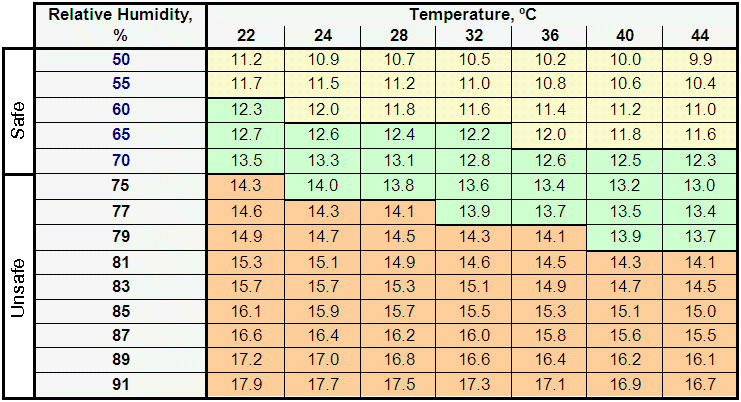How to determine the EMC
The following table shows the EMC of paddy under different storage conditions. The green colored areas represent the desirable environmental conditions for safe storage of paddy or rough rice in the tropics. The yellow areas represent conditions for safe seed storage. Grain needs to be stored at less than 14% moisture and seed at less than 12%.
Note: The colored fields in the table represent the ranges on the IRRI moisture meter:
- orange: wet paddy - needs to be dried
- green: safe for storing grain for milling / consumption
- yellow: safe for storing seeds
Example:
A paddy at 77% relative humidity and 32ºC air temperature will attain 13.9% moisture content (shown in green in the table above) that is, safe for storage. If at the same temperature, the relative humidity rises to 85% or higher, over time grain exposed to the ambient air will reach an equilibrium moisture content of approximately 15.5% (shown in orange in the table above) making the grain prone to quality deterioration.
The grain moisture content of paddy stored in jute bags or clay pots will automatically increase in the rainy season to unsafe levels regardless of how well the grain was dried before storage. Therefore, for long term storage of grain or seed in tropical climates it is crucial to prevent re-wetting of grain by humid air.
For more information on storage devices and facilities, please go to the modules on storage.
 If the grain is stored in an enclosed storage environment (for example, a bag, silo, etc), the air surrounding the grain if it is well sealed is not in free contact with outside air. In this case, the relative humidity of the enclosed air will reach equilibrium with the moisture content in the grain. The final relative humidity of the enclosed air is often expressed by the ‘equilibrium relative humidity’.
If the grain is stored in an enclosed storage environment (for example, a bag, silo, etc), the air surrounding the grain if it is well sealed is not in free contact with outside air. In this case, the relative humidity of the enclosed air will reach equilibrium with the moisture content in the grain. The final relative humidity of the enclosed air is often expressed by the ‘equilibrium relative humidity’.
The higher the grain moisture content of the stored grain, the higher the equilibrium relative humidity, and the higher the chances of mold development or loss of germination. In general, an equilibrium relative humidity inside the store of 65% or less is considered a safe prevention against the development of molds.
